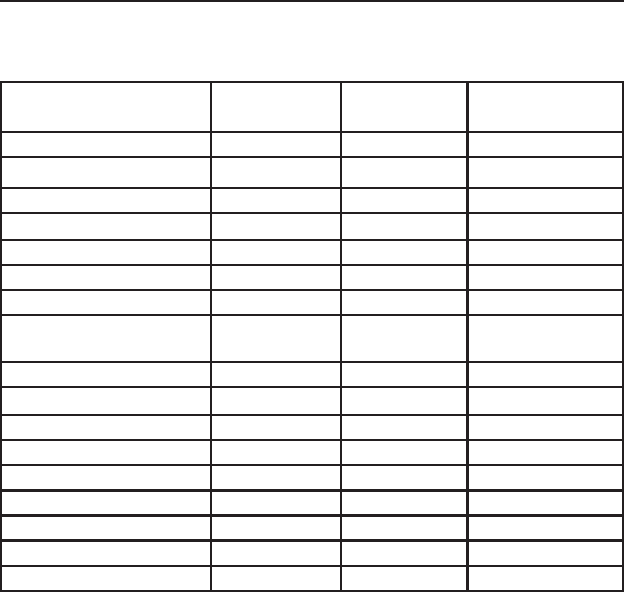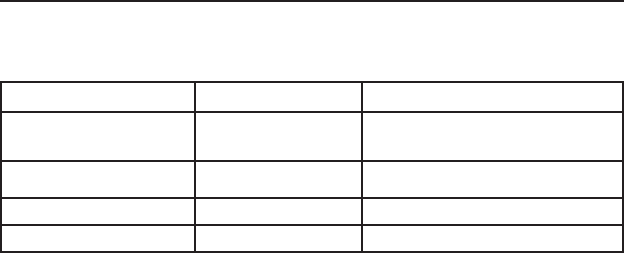Boston Scientific Neuromodulation SC5232 SC-5232 User Manual 90668515 01 Information for Prescribers indb
Boston Scientific Neuromodulation Corporation SC-5232 90668515 01 Information for Prescribers indb
Contents
User Manual 3

CAUTION: Federal law restricts this device to sale, distribu-
tion and use by or on the order of a physician.
Precision Spectra™ System
Information for Prescribers
90668515-01 REV A

Information for Prescribers
Precision Spectra™ System Information for Prescribers
90668515-01 Rev A ii of iv
Copyright
© 2012 Boston Scientifi c Corporation or its affi liates. All Rights Reserved. These docu-
ments are the property of Boston Scientifi c Corporation and shall not be reproduced,
distributed, disclosed, or used for manufacture or sale of device without the express
written consent of Boston Scientifi c Corporation.
Guarantees
Boston Scientifi c Corporation reserves the right to modify, without prior notice, infor-
mation relating to its products in order to improve their reliability or operating capacity.
Trademarks
Precision Spectra is a trademark of Boston Scientifi c. Other brands and their products
are trademarks or registered trademarks of their respective holders and should be
noted as such.

Table of Contents
Precision Spectra™ System Information for Prescribers
90668515-01 Rev A iii of iv
Refer to the Indications for Use for indications and related information.
Refer to the following Directions for Use (DFU) for device specifi c instructions: Precision
Spectra System Implantable Pulse Generator DFU, Surgical Leads DFU, Percutaneous
Leads DFU, Precision Spectra System Clinician Remote Control DFU, Clinician Trial Manual,
Precision Spectra System Programming Manual, and Programming Wand DFU.
Refer to the Limited Warranty for warranty information.
Table of Contents
Device and Product Description .................................................................. 1
Precision Spectra System Clinical Summary........................................................ 1
Contraindications ........................................................................................... 6
Safety Information ..........................................................................................6
Instructions for the Patient .................................................................................................. 6
Adverse Effects .................................................................................................................10
Instructions for the Physician ............................................................................................ 11
Sterilization ....................................................................................................................... 12
FCC Rules.......................................................................................................13
Technical Service...........................................................................................13
End of Programmed Service........................................................................14
IPG Battery Life.............................................................................................14

Information for Prescribers
Precision Spectra™ System Information for Prescribers
90668515-01 Rev A iv of iv
This page intentionally left blank.

Device and Product Description
Precision Spectra™ System Information for Prescribers
90668515-01 Rev A 1 of 15
Device and Product Description
The Precision Spectra™ Spinal Cord Stimulation System consists of an Implantable Pulse
Generator (IPG), temporary and permanent Percutaneous Leads, Surgical Paddle Leads,
Lead Extensions, OR Cables, Trial Stimulator, Remote Control, Clinician Programmer, and
Programming Wand, each packaged as a separate kit. Single use accessories and disposable
tools are also included in these kits.
Features of the Precision Spectra System include:
• Stimulation electrode fi eld navigation
• Thirty-two independent current-controlled electrodes
• Four programmable stimulation areas per program; sixteen possible programs
• Long-life operation
• High-range parameter capability
• Small size
• Two-foot programming range
• This product contains no detectable latex
Precision Spectra System Clinical Summary
Determination of the safety and effectiveness of the Precision Spectra System was based on
available published clinical studies for similar implanted spinal cord stimulation systems. The
Precision Spectra System is similar to the SCS systems reported in published literature in
intended use, target patient population, technology, device design, and output characteristics.
Therefore, the clinical data from the published literature described below represents evidence
supporting the safety and effectiveness of the Precision Spectra System for the treatment
chronic intractable pain of the trunk and/or limbs, including unilateral or bilateral pain associated
with the following: failed back surgery syndrome, intractable low back and leg pain.
Effi cacy Evaluation
Three (3) clinical literature studies were used to support the effectiveness of the Precision
Spectra™ System (Ohnmeiss et al. 1996, Villavincencio et al. 2000, Hassenbach SJ et al.
1995). The studies included a total of 116 patients that were implanted with an SCS system.
A total of approximately 3166 device months of experience was depicted from the retrospective
clinical evaluation. All three studies examined the effectiveness of SCS on patients with chronic
pain of the trunk and/or limbs including unilateral or bilateral pain associated with the following:
failed back surgery syndrome or intractable low back and leg pain. In all studies, a totally
implantable spinal cord stimulator was used in association with a percutaneous and/or surgical
lead. These studies provide the same diagnostic or therapeutic intervention for the same
disease/conditions and patient population as the Precision Spectra System.

Information for Prescribers
Precision Spectra™ System Information for Prescribers
90668515-01 Rev A 2 of 15
The prospective study by Ohnmeiss et al. 1996, examined the long-term effectiveness of SCS
in patients with intractable leg pain. Forty patients were implanted with SCS systems and
evaluated at 6 weeks, 12 months, and 24 months follow-up. Outcome measures included the
VAS, pain drawings, medication use, SIP (Sickness Impact Profi le), isometric lower extremity
testing, and patient questionnaires. An intent-to-treat analysis was performed. After patients
had SCS for 24 months, leg pain, pain when walking, standing pain, pain’s effect on overall
lifestyle, and the total analog scale scores were signifi cantly improved from baseline. In this
study, 25% of the implanted patients had greater than 50% improvement in pain rating.
In addition, 3 patients from this study had their stimulators repositioned due to pain at the
original location. Three patients had reoperations to adjust lead position; 1 patient required
2 reoperations, 1 patient had the device removed due to infection and later to have a new
device implanted. A diabetic patient had skin problems which required device removal; a new
device was later implanted. Two patients had the device removed due to unsatisfactory pain
relief.
The prospective study performed by Villavicencio et al. 2000 included 41 patients with
pain of various etiologies. The majority of the patients, 24 (59%), had Failed Back Surgery
Syndrome (FBSS), 7 (17%) had Complex Regional Pain Syndrome (CRPS I and II), 4 (10%)
had neuropathic pain syndrome, and 6 (15%) were diagnosed as stroke or other. Patients
underwent an initial trial period for SCS with temporary leads. If the trial resulted in greater than
50% reduction in the patient’s pain, as measured by the VAS, the patient was implanted with
a SCS system. In this study, 27/41 patients, 66%, had permanent implants. All patients were
examined after 6 weeks. Pain measurements were assessed at 3-6 month intervals for the
fi rst year and annually thereafter. The median long-term follow-up was 34 months. A total
of 24/27 (89%), reported greater than 50% reduction in pain.
Since the majority of the patients were treated for FBSS, this article supports the use of SCS
for the treatment of FBSS.
In this study, one patient required a revision because of electrode fracture. One patient required
removal of the system due to local infection. One patient required replacement of the IPG
due to mechanical failure. Overall, 16 of 27 (59%) patients required a total of 36 repositioning
procedures.
A retrospective analysis performed by Hassenbusch SJ et al. 1995 included patients with
chronic lower body pain, predominately neuropathic pain and pain either midline lower back
and/or unilateral or bilateral leg pain treated over a 5 year period. The study was a comparison
of SCS to spinal infusion of opioids. For patients with radicular pain involving one leg with or
without unilateral buttock pain, a trial of SCS was recommended fi rst. For patients with midline
back pain and /or bilateral leg pain, a trial of long-term spinal infusion was recommended fi rst.
If the patients failed screening with either of these modalities, the other was then tested. If the

Precision Spectra System Clinical Summary
Precision Spectra™ System Information for Prescribers
90668515-01 Rev A 3 of 15
treatment reduced the pain by 50%, the systems were internalized. A retrospective analysis
of patients with unilateral leg and/or buttock pain treated initially with SCS and bilateral leg or
mainly low back pain treated initially with spinal infusions of opioids was then done.
In this study, 42 patients were screened; 26 (62%) patients received spinal stimulation;
16 (38%) received opioids via a spinal infusion pump. Five patients did not receive adequate
pain relief with SCS; 3 (7%) of these patients underwent trial spinal infusions and had effective
pain relief.
There were 4 (10%) patients who underwent a trial of spinal infusion of opioid but did not
receive adequate pain relief; these patients were not tested with SCS. Pain severity was
rated using a verbal digital pain scale: “On a scale of 0 to 10 where 0 is no pain and 10 is the
worst pain you could ever imagine, what is your pain now?” 16/26 patients (62%) had greater
than 50% pain relief with SCS. In this study, 2/16 (13%) had greater than 50% pain relief
with opioids. Mean follow-up was 2.1 ± 0.3 years. This analysis supports the use of SCS for
intractable low back and leg pain.
In this study, 7 (17%) patients suffered complications after implantation of the device; 5 (12%)
patients required repositioning of catheter type electrodes and 2 patients required revision of
the stimulator generator.
Safety Evaluation
Eleven studies were identifi ed based on the detailed inclusion/exclusion criteria to demonstrate
the safety of the Precision Spectra™ System. The studies included a total of 1056 patients that
were trialed with SCS systems and 880 patients that received implants. The table below depicts
the number of patients, the number of events, and the percentage of occurrences of each event
compared to the total number of patients. It should be noted that citations cover both IPG and
RF Systems. The clinical experience reported in the literature on RF systems is relevant to
determining the safety of totally implantable IPG systems.

Information for Prescribers
Precision Spectra™ System Information for Prescribers
90668515-01 Rev A 4 of 15
Table 1: Summary of Risks Identifi ed in the Retrospective Clinical Studies
Risks # Patients With
Adverse Event
Intent-to-Treat
Basis N = 1056
Implanted Patient
Basis N = 880
Lead Migration 175 16.6% 19.9%
Infection 39 3.7% 4.4%
Epidural Hemorrhage 0 0% 0%
Seroma 0 0% 0%
Hematoma 1 0.1% 0.1%
Paralysis 0 0% 0%
CSF Leak 5 0.5% 0.6%
Over/Under Stimulation,
Ineffective Pain Control
46 4.4% 5.2%
Intermittent Stimulation 0 0% 0%
Pain Over Implant 16 1.5% 1.8%
Allergic Reaction 6 0.6% 0.7%
Skin Erosion 0 0% 0%
Lead Breakage 35 3.3% 4.0%
Hardware Malfunction 22 2.1% 2.5%
Loose Connection 0 0% 0%
Battery Failure 2 0.2% 0.2%
Other 45 4.3% 5.1%
Clinical Experience-Safety
Clinical data has been collected during a clinical study of the Precision System. As of January
15, 2004, 35 subjects were enrolled in the study at multiple sites and 26 subjects had a
successful trial stimulation period and were implanted with the Precision System. The follow-up
period for the 26 implanted patients ranged from two weeks to six months. The following major
adverse events were reported.

Precision Spectra System Clinical Summary
Precision Spectra™ System Information for Prescribers
90668515-01 Rev A 5 of 15
Table 2: Clinical Experience Safety
Type Number of Patients Resolution
Lead Migration 1 Lead repositioning and subsequent
replacement
Output malfunction 1 Device replaced
Infection 1 Infection treated
Pain 1 Lead explanted
Other minor adverse events reported by at least one patient included: receiver malfunction, skin
irritation, unpleasant stimulation, CSF leak, infection at implant site, lead migration, and OR
cable malfunction. Two of the subjects reported multiple events.
References
Burchiel, K.J., V.C. Anderson, F.D. Brown, R.G. Fessler, W.A. Friedman, S. Pelofsky, R.L.
Weiner, J. Oakley,and D. Shatin. “Prospective, Multicenter Study of Spinal Cord
Stimulation for Relief of Chronic Back and Extremity Pain.”Spine, 21:2786-2793, 1996.
Hassenbusch, S.J., M. Stanton-Hicks, E.C. Covington. “Spinal cord stimulation verses spinal
infusion for low back andleg pain”. Acta Neurochirgica, 64:109-115, 1995.
Kemler, M.A., G.A.M. Barendse, M. Van Kleef, H.C.W. De Vet, C.P.M. Rijks, C.A. Furnee and
F.A.J.M. Van den Wilderberg. “Spinal Cord Stimulation in Patients with Chronic Refl ex
Sympathetic Dystrophy.” New England J of Medicine, 343: 618-24, 2000.
Kim S. H., R.R. Tasker, and M.Y. Oh. “Spinal Cord Stimulation for Nonspecifi c Limb Pain versus
Neuropathic Pain and Spontaneous versus Evoked Pain.” Neurosurgery, 48(5):
1056-1064, 2001.
Kumar, K., C. Toth, R. Nath, and P. Lang. “Epidural Spinal Cord Stimulation for Treatment of
Chronic Pain-Some Predictors of Success. A 15 year experience.” Surg Neurol,
50: 110-120, 1998.
Lang, P. “The Treatment of Chronic Pain by Epidural Spinal Cord Stimulation.” AXON, 18(4):
71-73, 1997.
Ohnmeiss, D., R. Rashbaum, M. Bogdanffy. Prospective Outcome Evaluation of Spinal Cord
Stimulation in Patients With Intractable Leg Pain. Spine, 21:1344-1351, 1996.

Information for Prescribers
Precision Spectra™ System Information for Prescribers
90668515-01 Rev A 6 of 15
Rainov, N.G., V. Heidecke, and W. Burkert. “Short Test-Period Spinal CordStimulation for Failed
Back Surgery Syndrome.” Minim Invasive Neurosurg, 39(2):41-44, 1996.
Segal, R., B. Stacey, T. Rudy, S. Basser, J. Markham. “Spinal Cord Stimulation Revisited.”
Neurological Research, 20:391-396, 1998.
Spieglemann, R. and W.A. Friedman. “Spinal Cord Stimulation: A Contemporary Series.”
Neurosurg 28:65-71, 1991.
Villavicencio, A.T., J.C. Leveque, L. Rubin, K. Bulsara, and J.P. Gorecki. “Laminectomy versus
percutaneous electrode placement for spinal cord stimulation.” Neurosurgery, 46:399-406,
2000.
Contraindications
Patients contraindicated for permanent Spinal Cord Stimulation (SCS) therapy are those who:
• are unable to operate the SCS system
• have failed trial stimulation by failing to receive effective pain relief
• are poor surgical risks
• are pregnant
Safety Information
WARNING: Unauthorized modifi cation to the medical devices is prohibited. System integrity
could be compromised and harm or injury to the patient could occur if the medical devices are
subjected to unauthorized modifi cation.
Instructions for the Patient
Warnings
Heat Due to Charging. Patients should not charge while sleeping. This may result in a burn.
While charging, the Charger may become warm. It should be handled with care. Failure to
use the Charger with either the Charging Belt or an adhesive patch, as shown, may result in a
burn. If patients experience pain or discomfort, they should cease charging and contact Boston
Scientifi c.
Magnetic Resonance Imaging (MRI). Patients implanted with the Precision Spectra SCS
system should not be subjected to MRI. MRI exposure may result in dislodgement of implanted
components, heating of the neurostimulator, damage to the device electronics and/or voltage
induction through the leads and Stimulator causing an uncomfortable or “jolting” sensation.

Safety Information
Precision Spectra™ System Information for Prescribers
90668515-01 Rev A 7 of 15
Pediatric Use. The safety and effectiveness of spinal cord stimulation has not been established
for pediatric use.
Diathermy. Shortwave, microwave and/ or therapeutic ultrasound diathermy should not be
used on SCS patients. The energy generated by diathermy can be transferred through the
Stimulator system, causing tissue damage at the lead site and resulting in severe injury or
death. The IPG, whether it is turned on or off, may be damaged.
Implanted Stimulation Devices. Spinal cord stimulators may interfere with the operation of
implanted sensing stimulators such as pacemakers or cardioverter defi brillators. The effects of
implanted stimulation devices on neurostimulators is unknown.
Stimulator Damage. Burns may result if the pulse generator case is ruptured or pierced
and patient tissue is exposed to battery chemicals. Do not implant the device if the case is
damaged.
Postural Changes. Patients should be advised that changes in posture or abrupt movements
may cause decreases, or uncomfortable or painful increases in the perceived stimulation
level. Patients should be advised to turn down the amplitude or turn off the IPG before making
posture changes.
Important: If unpleasant sensations occur, the IPG should be turned off immediately.
Electromagnetic Interference. Strong electromagnetic fi elds can potentially turn the
Stimulator off, or cause uncomfortable or jolting stimulation. Patients should be counseled to
avoid or exercise care around:
• Theft detectors or security screeners such as those used at entrances/exits of department
stores, libraries, and other public establishments, and/or airport security screening devices.
It is recommended that patients request assistance to bypass the device. If they must
proceed through the device, the patient should turn off the Stimulator and proceed with
caution, moving through the center of the screener as quickly as possible.
• Power lines or power generators
• Electric steel furnaces and arc welders
• Large, magnetized stereo speakers

Information for Prescribers
Precision Spectra™ System Information for Prescribers
90668515-01 Rev A 8 of 15
Precautions
Physician training is required.
Medical Devices/Therapies. The following medical therapies or procedures may turn
stimulation off or may cause permanent damage to the Stimulator, particularly if used in close
proximity to the device:
• lithotripsy
• electrocautery (See “Instructions for the Physician” on page 11)
• external defi brillation
• radiation therapy (Any damage to the device by radiation may not be immediately
detectable.)
• ultrasonic scanning
• high-output ultrasound
If any of the above is required by medical necessity, refer to “Instructions for the Physician” on
page 11. Ultimately, however, the device may require explantation as a result of damage to
the device.
Automobiles and Other Equipment. Patients should not operate automobiles, other
motorized vehicles, or potentially dangerous machinery/ equipment with therapeutic stimulation
switched on. Stimulation must be turned off fi rst. Sudden stimulation changes, if they occur,
may distract patients from attentive operation of the vehicle or equipment.
Post Operative. During the two weeks following surgery, it is important that patients use
extreme care so that appropriate healing will secure the implanted components and close the
surgical incisions:
• Patients should not lift objects of more than fi ve pounds.
• Patients should not engage in rigorous physical activity such as twisting, bending, or
climbing.
• If new leads were implanted, patients should not raise their arms above their head.
Temporarily, there may be some pain in the area of the implant as the incisions heal. Patients
should be instructed that if discomfort continues beyond two weeks, they should contact their
physician.
If patients notice excessive redness around the wound areas during this time, they should
contact their physician to check for infection and administer proper treatment. In rare cases,
adverse tissue reaction to implanted materials can occur during this period.
Patients should consult their physician before making lifestyle changes due to decreases in
pain.

Safety Information
Precision Spectra™ System Information for Prescribers
90668515-01 Rev A 9 of 15
Stimulator Location. Patients should never attempt to change the orientation or “fl ip” (rotate
or spin) the Stimulator. Patients should not “fi nger” or play with the Stimulator. If the Stimulator
fl ips over in the Patient’s body, it cannot be charged. If the Patient knows that the device has
turned, or if stimulation cannot be turned on after charging, the Patient should contact his or her
physician to arrange an evaluation of the system. In some cases, the skin over the Stimulator
may become very thin over time. If this occurs, Patients should contact their physicians.
Lead Location. In some instances a lead can move from its original location, and stimulation
at the intended pain site can be lost. If this occurs, Patients should consult their physician who
may able to restore stimulation by reprogramming the Stimulator in the clinic or repositioning
the lead during another operation.
Device Failure. Stimulators can fail at any time due to random component failure, loss of
battery functionality, or lead breakage. If the device stops working even after complete charging
(up to four hours), Patients should turn off the Stimulator and contact their physician so that the
system can be evaluated.
Operating Temperature. The operating temperature of the Trial Stimulator, Remote Control,
and Programming Wand is 10–40 °C (50–104 °F). For proper operation, do not use the
Charger if the ambient temperature is above 35 °C (95 °F).
Storage, Handling and Transport. Do not expose the Remote Control or Charging System
components to excessively hot or cold conditions. Do not leave the devices in your car
or outdoors for extended periods of time. The sensitive electronics can be damaged by
temperature extremes, particularly high heat.
If the Remote Control or the Charging System is to be stored for a period of time without
batteries, the storage temperature should not exceed -20 to 60 °C (-4 to 140 °F).
Handle the system external components and accessories with care. Do not drop them or
submerge them in water. Although reliability testing has been performed to ensure quality
manufacturing and performance, dropping the devices on hard surfaces or in water, or other
rough handling, can permanently damage these components. (See “Limited Warranty - IPG”.)
Upon completion of the Patient Trial, remove the batteries from the Trial Stimulator.
Component Disposal. Do not dispose of the Remote Control or Charger in fi re. The battery
in these devices can explode in fi re. Dispose of used batteries in accordance with local
regulations. The IPG should be explanted in the case of cremation, and returned to Boston
Scientifi c. External devices to be disposed of per local regulatory requirements. Please contact
your healthcare professional.

Information for Prescribers
Precision Spectra™ System Information for Prescribers
90668515-01 Rev A 10 of 15
Remote Control, Charging System, External Trial Stimulator and Wand Cleaning. The
charging system components can be cleaned using alcohol or a mild detergent applied with a
cloth or tissue. The Remote Control, External Trial Stimulator and Programming Wand can be
cleaned using a mild detergent applied with a lightly dampened cloth or tissue. Residue from
soapy detergents should be removed with a cloth lightly dampened with water. Do not use
abrasive cleansers for cleaning. Cleaning wipes for the External Trial Stimulator can also be
ordered through Boston Scientifi c customer service.
Cell Phones. While we do not anticipate any interference with cell phones, the full effects
of interaction with cell phones are unknown at this time. If there is a concern or a problem is
encountered, the patients should contact their physician.
Adverse Effects
Potential risks are involved with any surgery.
The possible risks of implanting a pulse generator as part of a system to deliver spinal cord
stimulation include:
• Lead migration, resulting in undesirable changes in stimulation and subsequent reduction in
pain relief.
• System failure, which can occur at any time due to random failure(s) of the components
or the battery. These events, which may include device failure, lead breakage, hardware
malfunctions, loose connections, electrical shorts or open circuits and lead insulation
breaches, can result in ineffective pain control.
• Tissue reaction to implanted materials can occur.
• Skin erosion at the IPG site can occur over time.
• Possible surgical procedural risks are: temporary pain at the implant site, infection,
cerebrospinal fl uid (CSF) leakage and, although rare, epidural hemorrhage, seroma,
hematoma and paralysis.
• External sources of electromagnetic interference may cause the device to malfunction and
affect stimulation.
• Exposure to MRI can result in heating of tissue, image artifacts, induced voltages in the
neurostimulator and/or leads, lead dislodgement.
• Undesirable stimulation may occur over time due to cellular changes in tissue around the
electrodes, changes in electrode position, loose electrical connections and/or lead failure.
• The patient may experience painful electrical stimulation of the chest wall as a result of
stimulation of certain nerve roots several weeks after surgery.
• Over time, the Stimulator may move from its original position.
• Weakness, clumsiness, numbness or pain below the level of implantation.
• Persistent pain at the IPG or lead site.
In any event, instruct the patient to contact their physician to inform him/her.

Instructions for the Physician
Precision Spectra™ System Information for Prescribers
90668515-01 Rev A 11 of 15
Instructions for the Physician
Implanted Stimulation Devices. If such implanted devices are indicated for the patient,
careful screening is required to determine if safe results can be achieved before permanently
implementing concurrent electrical therapies.
Postural Changes. Depending on the activity level of the patient, postural changes may affect
stimulation intensity. Instruct patients to keep the Remote Control on hand at all times, and
ensure that they understand how to adjust stimulation levels. Refer to Postural Changes in the
Instructions for Patients section of this manual, page 7, for additional information.
Medical Devices/Therapies. If the patient is required to undergo lithotripsy, electrocautery,
external defi brillation, radiation therapy, ultrasonic scanning, or high-output ultrasound:
• Turn off stimulation at least fi ve minutes before the procedure or application.
• All equipment, including ground plates and paddles, must
be used as far away from the IPG as possible.
• Every effort should be taken to keep fi elds, including current, radiation,
or high-output ultrasonic beams, away from the IPG.
• Equipment should be set to the lowest energy setting clinically indicated.
• Instruct patients to confi rm IPG functionality following treatment by turning
on the IPG and gradually increasing stimulation to the desired level.

Information for Prescribers
Precision Spectra™ System Information for Prescribers
90668515-01 Rev A 12 of 15
Sterilization
All Precision Spectra™ System implantable and surgical components are sterilized with
ethylene oxide.
• Inspect the condition of the sterile package before opening the package and
using the contents. Do not use the contents if the package is broken or torn, or
if contamination is suspected because of a defective sterile package seal.
• Do not use any component that shows signs of damage.
• Do not resterilize the package or the contents. Obtain
a sterile package from Boston Scientifi c.
• Do not use if the product is past the labeled expiration date.
• All components are for single use only. Do not reuse.
• Do not use if package is opened or damaged
• Do not use if labeling is incomplete or illegibl
WARNING: Contents supplied STERILE using an ethylene oxide (EO) process. Do not use
if sterile barrier is damaged. If damage is found, call your Boston Scientifi c representative.
For Single Use Only.
Do Not Reuse.
Do Not Resterilize
Do not use if package is damaged
For single patient use only. Do not reuse, reprocess or resterilize. Reuse, reprocessing or
resterilization may compromise the structural integrity of the device and/or lead to device
failure which, in turn, may result in patient injury, illness or death. Reuse, reprocessing or
resterilization may also create a risk of contamination of the device and/or cause patient
infection or crossinfection, including, but not limited to, the transmission of infectious disease(s)
from one patient to another. Contamination of the device may lead to injury, illness or death of
the patient.
After use, dispose of product and packaging in accordance with hospital, administrative and/or
local government policy.

Sterilization
Precision Spectra™ System Information for Prescribers
90668515-01 Rev A 13 of 15
FCC Rules
The following is federal government communications regulation information about the Precision
Spectra™ Spinal Cord Stimulation System.
This device complies with part 15 of the FCC Rules. Operation is subject to the following two
conditions: (1) This device may not cause harmful interference, and (2) This device must accept
any interference received including interference that may cause undesired operation.
The Precision Spectra™ System components should only be serviced by Boston Scientifi c. Do
not attempt to open or repair any of the components. Unauthorized opening of or attempts to
repair the components will void the warranty.
Changes of modifi cations to this product not authorized by Boston Scientifi c Corporation could
void the FCC Certifi cation and negate your authority to operate this product.
Technical Service
Boston Scientifi c has highly trained service professionals located worldwide to assist you. The
Technical Service Department is available to provide technical consultation 24 hours a day.
In North America, please call (866) 566-8913 to speak to a representative.

Information for Prescribers
Precision Spectra™ System Information for Prescribers
90668515-01 Rev A 14 of 15
End of Programmed Service
The Precision Spectra™ System IPG software is programmed to end service after 12 years.
As the IPG nears the end of the programmed period, the Precision Spectra System Remote
Control and Precision Spectra System Clinician Programmer provide the following indicators to
inform the user that the end of the programmed period is approaching:
• Remote Control - Approximately six months before the end of the programmed
period, the Remote Control displays a weekly message indicating the
number of service days remaining. Approximately one month before
the end of the programmed period, the message displays daily.
• Clinician Programmer - When less than six months of service period remain, an indicator
displays on the Connect screen of the Clinician Programmer. When end of the programmed
period has been reached, a message displays when connecting to the Stimulator to indicate
that the end of the programmed period has been reached and programming is not allowed.
Patients should contact their health care provider upon fi rst receiving a message regarding the
number of programmed service period days remaining.
IPG Batttery Life
The rechargeable battery in the Precision Spectra System IPG should provide at least fi ve
years of service.1 The IPG recharge interval at typical settings is at least 30 days.2 Over time,
the IPG battery will need more frequent recharges. Like all rechargeable batteries, use over
time and repeated recharge cycles reduce the maximum charge capacity of the IPG battery.
1 The expected years of battery operation are defi ned as the longer of either:
A. Typical case: the time at which therapy cannot be maintained with daily charging.
OR
B. High energy case: when the maximum recharge interval has decreased by more than 50 % from the initial recharge
interval.
2 This estimated recharge interval is based on the following assumptions:
• The Precision Spectra IPG is newly implanted and at the beginning of it’s charging life.
• The IPG has been programmed to the following settings: Current amplitude: 4 mA; Pulse Width: 300 μs; Pulse Rate:
50 Hz and Impedance: 750 Ohms.
NOTE: Your actual settings may vary, thus varying the number of days for your recharge interval.

Sterilization
Precision Spectra™ System Information for Prescribers
90668515-01 Rev A 15 of 15
This page intentionally left blank.

Corporate Headquarters
Boston Scientifi c Neuromodulation
25155 Rye Canyon Loop
Valencia, CA 91355 USA
(866) 789-5899 in US and Canada
(661) 949-4000, (661) 949-4022 Fax
(866) 789-6364 TTY
www.bostonscientifi c.com
Email: neuro.info@bsci.com
© 2012 Boston Scientifi c Corporation
or its affi liates. All rights reserved.
90668515-01 REV A 2012-04